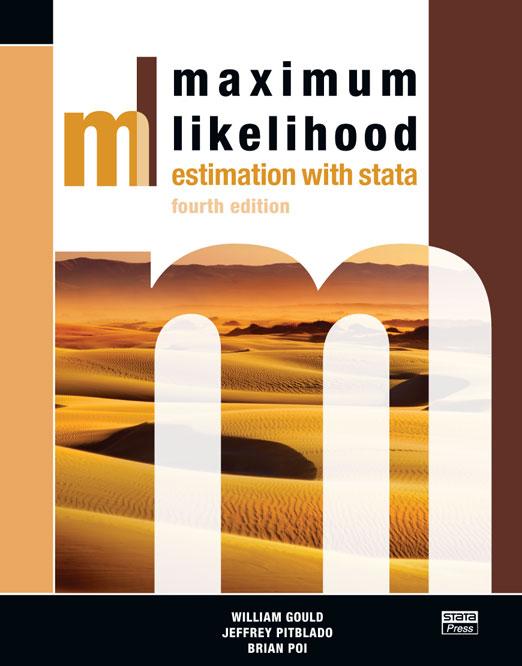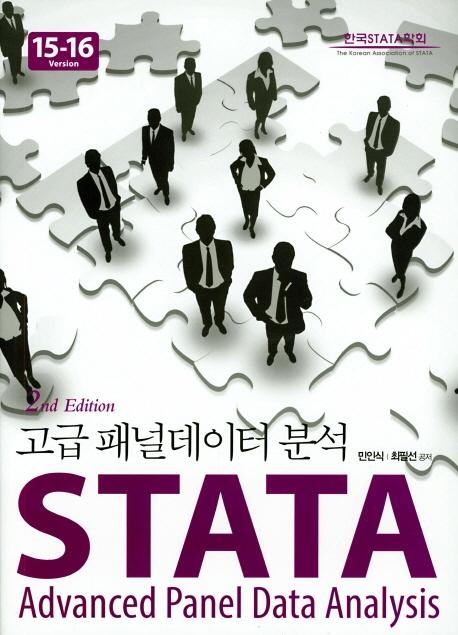
Maximum Likelihood Estimation with Stata, Fourth Edition
87,000원 70,000원
Authors: William Gould, Jeffrey Pitblado, and Brian Poi Publisher: Stata Press Copyright: 2010 ISBN-13: 978-1-59718-078-8 Pages: 352; paperback
Maximum Likelihood Estimation with Stata, Fourth Edition is the essential reference and guide for researchers in all disciplines who wish to write maximum likelihood (ML) estimators in Stata. Beyond providing comprehensive coverage of Stata’s ml command for writing ML estimators, the book presents an overview of the underpinnings of maximum likelihood and how to think about ML estimation.
The book shows you how to take full advantage of the ml command’s noteworthy features:
- linear constraints
- four optimization algorithms (Newton–Raphson, DFP, BFGS, and BHHH)
- observed information matrix (OIM) variance estimator
- outer product of gradients (OPG) variance estimator
- Huber/White/sandwich robust variance estimator
- cluster–robust variance estimator
- complete and automatic support for survey data analysis
- direct support of evaluator functions written in Mata
When appropriate options are used, many of these features are provided automatically by ml and require no special programming or intervention by the researcher writing the estimator.
The fourth edition has been updated to include new features introduced in recent versions of Stata. Such features include new methods for handling scores, more consistent arguments for likelihood-evaluator programs, and support for likelihood evaluators written in Mata (Stata’s matrix programming language). The authors illustrate how to write your estimation command so that it fully supports factor-variable notation and the svyprefix for estimation with survey data. They have also restructured the chapters that introduce ml in a way that allows you to begin working with mlfaster. This edition is essential for anyone using Stata 11.
In the final chapter, the authors illustrate the major steps required to get from log-likelihood function to fully operational estimation command. This is done using several different models: logit and probit, linear regression, Weibull regression, the Cox proportional hazards model, random-effects regression, and seemingly unrelated regression.
The authors provide extensive advice for developing your own estimation commands. With a little care and the help of this book, users will be able to write their own estimation commands—commands that look and behave just like the official estimation commands in Stata.
Whether you want to fit a special ML estimator for your own research or wish to write a general-purpose ML estimator for others to use, you need this book.
William Gould is President of StataCorp and heads the technical development of Stata. Gould is also the architect of Mata, Stata’s matrix programming language.
Jeff Pitblado is Executive Director of Statistical Software at StataCorp. Pitblado has played a leading role in the development of ml: he added the ability of ml to work with survey data and he wrote the current implementation of ml in Mata.
Brian Poi was Senior Economist at StataCorp. On the software development side, he wrote a variety of econometric estimators in Stata.
1.2 Likelihood theory
1.2.2 Likelihood-ratio tests and Wald tests
1.2.3 The outer product of gradients variance estimator
1.2.4 Robust variance estimates
The Newton–Raphson algorithm
The DFP and BFGS algorithms
1.3.4 Numerical derivatives
1.3.5 Numerical second derivatives
2.2 Normal linear regression
2.3 Robust standard errors
2.4 Weighted estimation
2.5 Other features of method-gf0 evaluators
2.6 Limitations
3.2 Equations in ml
3.3 Likelihood-evaluator methods
3.4 Tools for the ml programmer
3.5 Common ml options
3.5.2 Weights
3.5.3 OPG estimates of variance
3.5.4 Robust estimates of variance
3.5.5 Survey data
3.5.6 Constraints
3.5.7 Choosing among the optimization algorithms
4.2 Examples
4.2.2 Normal linear regression
4.2.3 The Weibull model
4.4 Problems you can safely ignore
4.5 Nonlinear specifications
4.6 The advantages of lf in terms of execution speed
5.2 Outline of evaluators of methods lf0, lf1, and lf2
5.2.2 The b argument
5.2.4 Arguments for scores
5.2.5 The H argument
5.3.2 Method lf1
5.3.3 Method lf2
5.4.2 Normal linear regression
5.4.3 The Weibull model
6.2 Outline of method d0, d1, and d2 evaluators
6.2.2 The b argument
6.2.3 The lnf argument
Using mlsum to define lnf
6.3.2 Method d1
6.3.3 Method d2
6.4.2 Calculating g
6.4.3 Calculating H
7.2 Using the debug methods
7.2.2 Second derivatives
8.2 ml plot
8.3 ml init
9.2 Pressing the Break key
9.3 Maximizing difficult likelihood functions
10.2 Redisplaying output
11.1.2 The Weibull model
lf-family evaluators
d-family evaluators
Obtaining model parameters
Summing individual or group-level log likelihoods
Calculating the gradient vector
Calculating the Hessian
11.4.2 Calculating g
11.4.3 Calculating H
11.4.4 Results at last
12.2 Putting the do-file into production
13.2 The standard estimation-command outline
13.3 Outline for estimation commands using ml
13.4 Using ml in noninteractive mode
13.5 Advice
13.5.2 Estimation subsample
13.5.3 Parsing with help from mlopts
13.5.4 Weights
13.5.5 Constant-only model
13.5.6 Initial values
13.5.7 Saving results in e()
13.5.8 Displaying ancillary parameters
13.5.9 Exponentiated coefficients
13.5.10 Offsetting linear equations
13.5.11 Program properties
14.2 Writing your own predict command
15.2 The probit model
15.3 Normal linear regression
15.4 The Weibull model
15.5 The Cox proportional hazards model
15.6 The random-effects regression model
15.7 The seemingly unrelated regression model
B.2 Method d0
B.3 Method d1
B.4 Method d2
B.5 Method lf0
B.6 Method lf1
B.7 Method lf2
C.2 The probit model
C.3 The normal model
C.4 The Weibull model
C.5 The Cox proportional hazards model
C.6 The random-effects regression model
C.7 The seemingly unrelated regression model




